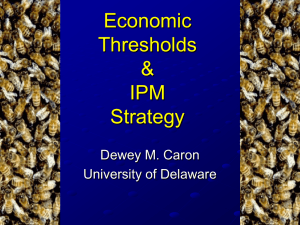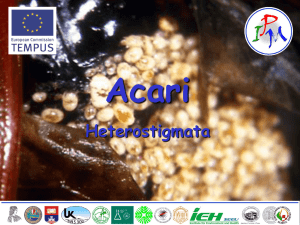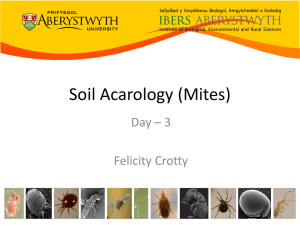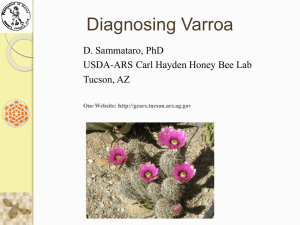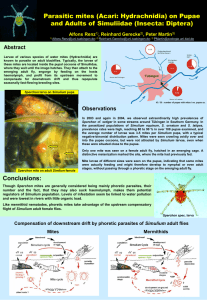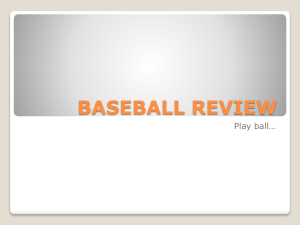51KB - NZQA
advertisement
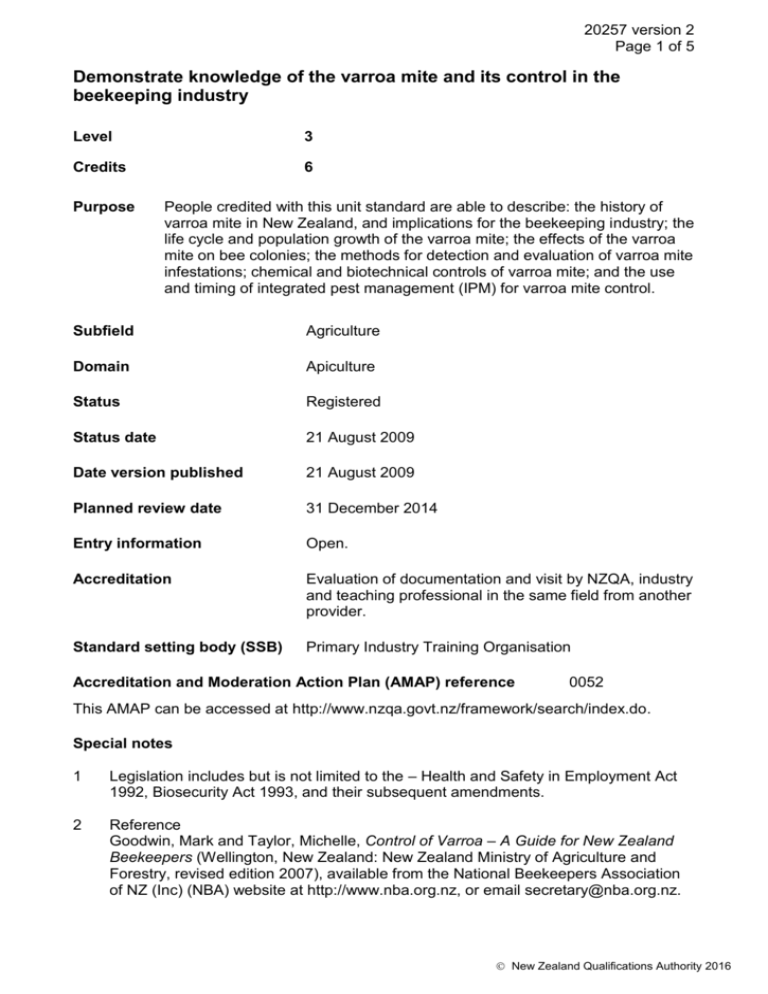
20257 version 2 Page 1 of 5 Demonstrate knowledge of the varroa mite and its control in the beekeeping industry Level 3 Credits 6 Purpose People credited with this unit standard are able to describe: the history of varroa mite in New Zealand, and implications for the beekeeping industry; the life cycle and population growth of the varroa mite; the effects of the varroa mite on bee colonies; the methods for detection and evaluation of varroa mite infestations; chemical and biotechnical controls of varroa mite; and the use and timing of integrated pest management (IPM) for varroa mite control. Subfield Agriculture Domain Apiculture Status Registered Status date 21 August 2009 Date version published 21 August 2009 Planned review date 31 December 2014 Entry information Open. Accreditation Evaluation of documentation and visit by NZQA, industry and teaching professional in the same field from another provider. Standard setting body (SSB) Primary Industry Training Organisation Accreditation and Moderation Action Plan (AMAP) reference 0052 This AMAP can be accessed at http://www.nzqa.govt.nz/framework/search/index.do. Special notes 1 Legislation includes but is not limited to the – Health and Safety in Employment Act 1992, Biosecurity Act 1993, and their subsequent amendments. 2 Reference Goodwin, Mark and Taylor, Michelle, Control of Varroa – A Guide for New Zealand Beekeepers (Wellington, New Zealand: New Zealand Ministry of Agriculture and Forestry, revised edition 2007), available from the National Beekeepers Association of NZ (Inc) (NBA) website at http://www.nba.org.nz, or email secretary@nba.org.nz. New Zealand Qualifications Authority 2016 20257 version 2 Page 2 of 5 Elements and performance criteria Element 1 Describe the history of varroa mite in New Zealand, and implications for the beekeeping industry. Performance criteria 1.1 The history of varroa mite is described in terms of its relationship to honey bees, and its introduction into New Zealand. 1.2 The varroa mite is described in terms of the results of no action, steps for control, and the implications of the use of chemicals in the beekeeping industry. Element 2 Describe the life cycle and population growth of the varroa mite. Performance criteria 2.1 The varroa mite is described in terms of its identifying features. Range size, colour, shape, movement. 2.2 The varroa mite is described in terms of its activity within the beehive, and methods of infestation between beehives. 2.3 The varroa mite is described in terms of its life cycle within the beehive. 2.4 Population growth rates of varroa mite are described in terms of the affects on bee population growth rate, and methods for population growth control. Range reproduction process and population growth rate, invasion and population growth rate, acute versus chronic infestation, control methods and population growth rates. Element 3 Describe the effects of the varroa mite on bee colonies. Performance criteria 3.1 The varroa mite is described in terms of the effects on adult bees. Range 3.2 haemolymph, viral infection. The varroa mite is described in terms of the effects on bee larvae or pupae. Range evidence is required for at least six effects. New Zealand Qualifications Authority 2016 20257 version 2 Page 3 of 5 3.3 The varroa mite is described in terms of the effects on feral and managed bee colonies. Range 3.4 effects on – colony production, pollination. The varroa mite is described in terms of its contribution to the presence of parasitic mite syndrome. Element 4 Describe the methods for detection and evaluation of varroa mite infestations. Performance criteria 4.1 Varroa mite infestations are described in terms of the visual symptoms present in bees, larvae, and pupae. 4.2 Varroa mite infestations are described in terms of the methods for detection in beehives, and the advantages, disadvantages, and threshold for each detection method. Range 4.3 Methods of detection of varroa mite infestations are compared and evaluated for a given situation. Range 4.4 sampling, visual inspection (bees, brood), ether roll; soapy water or alcohol, sugar shake, mesh bottom boards; chemical detection – Apistan, Bayvarol, formic acid. cost, time required, visits needed, sensitivity, reliability. Sticky boards and mesh bottom boards are described in terms of construction and use in determining reduction of varroa mite population levels. Element 5 Describe chemical and biotechnical controls of varroa mite. Performance criteria 5.1 Synthetic chemicals used for varroa mite control are described in terms of method of application, effectiveness, and limitations. Range fluvalinate (Apistan), flumethrin (Bayvarol), coumaphos (CheckMite+, Perizin), cymiazole (Apitol), bromopropylate (Folbex), amitraz (Apivar). New Zealand Qualifications Authority 2016 20257 version 2 Page 4 of 5 5.2 Organic chemicals used for varroa mite control are described in terms of application methods, effectiveness, and limitations. Range 5.3 essential oils – thymol, apiguard, apilife VAR, thymovar, food grade mineral oil; organic acids – formic acid, oxalic acid, lactic acid; vegetable and other oils, icing sugar. Chemical control of varroa mite is described in terms of residue effects and ways residue can be minimised. Range evidence is required for at least five ways to minimise residue. 5.4 Chemical resistance in varroa mite is described in terms of the reasons for its occurrence, cross resistance, methods for slowing resistance, and methods for measuring resistance. 5.5 Biotechnical controls of varroa mite are described in terms of methods, advantages and disadvantages. Range worker brood removal, drone brood trapping, hive splitting, queen isolation, mesh bottom boards, pollen trap, heat treatment, change of cell size, eliminating production of drone brood. Element 6 Describe the use and timing of integrated pest management (IPM) for varroa mite control. Performance criteria 6.1 IPM is described in terms of economic threshold. 6.2 IPM is described in terms of monitoring. Range 6.3 IPM is described in terms of the choice of control method for a given situation. Range 6.4 availability, cost, residues, resistance, toxicity, environmental concerns. The timing of a varroa control programme is described in terms of the factors to be taken into account when deciding when to treat hives for varroa mite. Range 6.5 acute stage, chronic stage, number of hives to survey. evidence is required for at least four factors. Types of treatment programme are described in terms of timing, and advantages and disadvantages for specified situations. Range prophylactic treatment, calendar treatment, treatment based on monitoring and economic thresholds, IPM. New Zealand Qualifications Authority 2016 20257 version 2 Page 5 of 5 6.6 The timing of treatments is described in terms of advantages for varroa mite control. Range reducing residues, changes to management programmes, coordinated treatments, spring treatments, autumn treatments. Please note Providers must be accredited by NZQA, or an inter-institutional body with delegated authority for quality assurance, before they can report credits from assessment against unit standards or deliver courses of study leading to that assessment. Industry Training Organisations must be accredited by NZQA before they can register credits from assessment against unit standards. Accredited providers and Industry Training Organisations assessing against unit standards must engage with the moderation system that applies to those standards. Accreditation requirements and an outline of the moderation system that applies to this standard are outlined in the Accreditation and Moderation Action Plan (AMAP). The AMAP also includes useful information about special requirements for organisations wishing to develop education and training programmes, such as minimum qualifications for tutors and assessors, and special resource requirements. Comments on this unit standard Please contact the Primary Industry Training Organisation standards@primaryito.ac.nz if you wish to suggest changes to the content of this unit standard. New Zealand Qualifications Authority 2016
